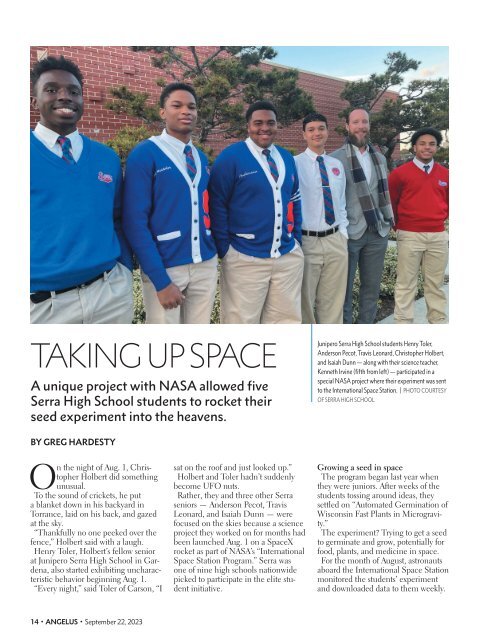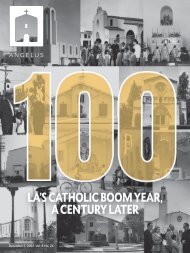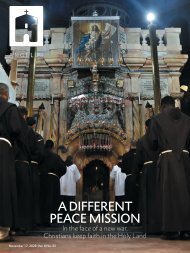Create successful ePaper yourself
Turn your PDF publications into a flip-book with our unique Google optimized e-Paper software.
TAKING UP SPACE<br />
A unique project with NASA allowed five<br />
Serra High School students to rocket their<br />
seed experiment into the heavens.<br />
BY GREG HARDESTY<br />
Junipero Serra High School students Henry Toler,<br />
Anderson Pecot, Travis Leonard, Christopher Holbert,<br />
and Isaiah Dunn — along with their science teacher,<br />
Kenneth Irvine (fifth from left) — participated in a<br />
special NASA project where their experiment was sent<br />
to the International Space Station. | PHOTO COURTESY<br />
OF SERRA HIGH SCHOOL<br />
Students won’t get the full results of<br />
their experiment until the astronauts<br />
return, but the belief is the seed in<br />
space will grow at a rate comparable<br />
to the rate in a parallel experiment on<br />
Earth — if the seed receives enough<br />
water.<br />
Getting a seed to grow in space<br />
requires a pump, water, fans, wicking<br />
materials, LED grow lights, and a<br />
nutrient solution.<br />
The pump delivers water to the seed,<br />
which is covered in a wicking material<br />
— an absorbent cloth — for the seed<br />
to consistently receive water.<br />
Fans move oxygen and carbon dioxide<br />
around the chamber, and light is<br />
needed for taking photos and growing<br />
the plant.<br />
By using grow lights, the plant would<br />
be able to carry out photosynthesis and<br />
flourish once germinated — or so the<br />
theory goes. Things are different in<br />
space.<br />
The students used a variety of the<br />
Wisconsin Fast Plant due to it being<br />
able to grow in the timeframe of the<br />
experiment.<br />
So, what’s the point of trying to grow<br />
a seed in space?<br />
Plants and food would be necessary<br />
for potentially living in space, as well<br />
as for medicinal use for the potential<br />
treatment of diseases. The experiment<br />
also may help design systems for<br />
removing carbon dioxide from a sealed<br />
environment while contributing oxygen<br />
back to the surroundings, which<br />
could be helpful in long-term space<br />
flight and living situations.<br />
Finally, the experiment also could<br />
yield information that could contribute<br />
to the development of agricultural<br />
systems on Earth.<br />
and Dunn were the only remaining<br />
students to see the project to its completion.<br />
“It was a process, with deadline after<br />
deadline,” Irvine said. “We had two<br />
to three weeks to come up with the<br />
experiment. At first, it kind of felt like<br />
‘Looney Tunes,’ where the train is going<br />
off the cliff and they’re still laying<br />
down the track below.”<br />
Pecot, who handled many of the<br />
electrical duties involved in the experiment,<br />
said he thought the project<br />
— conducted in collaboration with<br />
the Quest Institute, an educational<br />
nonprofit organization that develops<br />
and markets STEM educational programs<br />
and materials for K-12 schools<br />
— was far-fetched when he first heard<br />
about it.<br />
“When people say they want to grow<br />
up and be an astronaut, that’s far in the<br />
future,” Pecot said. “To be able to be<br />
doing this in high school didn’t seem<br />
possible. But this experience has been<br />
amazing.”<br />
Meanwhile, on Earth<br />
As the students await word on how<br />
their experiment went, they recall a<br />
process that was a lot of work — they<br />
each toiled on it a total of about 120<br />
hours — but very rewarding.<br />
“It was definitely an experience,”<br />
said Toler, who with Leonard handled<br />
the mechanical engineering aspect<br />
of the project. Dunn was the software<br />
engineer and Holbert also tackled<br />
electrical and mechanical engineering<br />
duties. “We all have a lot of other<br />
things going on as high school students.<br />
Being able to do this shows our<br />
dedication, grit, and motivation.”<br />
The ISSP program also sent the<br />
students to the USC Viterbi School of<br />
Engineering to stoke their interest in<br />
engineering.<br />
“During their visit, the students<br />
participated in a Broader Impact<br />
workshop, which is part of a multi-university<br />
(National Science Foundation)<br />
superconducting workshop that USC<br />
Viterbi is a part of,” said Darin Gray,<br />
Ed.D., co-director of the USC Viterbi<br />
K-12 STEM Center, which hosted the<br />
students.<br />
During the visit, the students conceptualized<br />
the societal impacts of<br />
their research and toured the school’s<br />
innovative Baum Family Maker Space.<br />
Irvine said that in addition to his<br />
students, the experience was rewarding<br />
for him, too.<br />
“My biggest goal was teaching the<br />
team the skills and how to use the<br />
tools, without giving them the answer<br />
to the problems they were trying to<br />
solve,” he said. “And they all did an<br />
excellent job.”<br />
Greg Hardesty was a journalist for the<br />
Orange County Register for 17 years,<br />
and is a longtime contributing writer to<br />
the Orange County Catholic newspaper.<br />
On the night of Aug. 1, Christopher<br />
Holbert did something<br />
unusual.<br />
To the sound of crickets, he put<br />
a blanket down in his backyard in<br />
Torrance, laid on his back, and gazed<br />
at the sky.<br />
“Thankfully no one peeked over the<br />
fence,” Holbert said with a laugh.<br />
Henry Toler, Holbert’s fellow senior<br />
at Junipero Serra High School in Gardena,<br />
also started exhibiting uncharacteristic<br />
behavior beginning Aug. 1.<br />
“Every night,” said Toler of Carson, “I<br />
sat on the roof and just looked up.”<br />
Holbert and Toler hadn’t suddenly<br />
become UFO nuts.<br />
Rather, they and three other Serra<br />
seniors — Anderson Pecot, Travis<br />
Leonard, and Isaiah Dunn — were<br />
focused on the skies because a science<br />
project they worked on for months had<br />
been launched Aug. 1 on a SpaceX<br />
rocket as part of NASA’s “International<br />
Space Station Program.” Serra was<br />
one of nine high schools nationwide<br />
picked to participate in the elite student<br />
initiative.<br />
Growing a seed in space<br />
The program began last year when<br />
they were juniors. After weeks of the<br />
students tossing around ideas, they<br />
settled on “Automated Germination of<br />
Wisconsin Fast Plants in Microgravity.”<br />
The experiment? Trying to get a seed<br />
to germinate and grow, potentially for<br />
food, plants, and medicine in space.<br />
For the month of August, astronauts<br />
aboard the International Space Station<br />
monitored the students’ experiment<br />
and downloaded data to them weekly.<br />
Preparing for liftoff<br />
Kenneth Irvine, science teacher and<br />
Science Department chair at Serra,<br />
worked closely with the students<br />
during their junior year to ensure the<br />
project would, well, get off the ground.<br />
Many students who initially got involved<br />
in the project were members of<br />
the chapter of the National Society of<br />
Black Engineers (NSBE) that had just<br />
opened at the school.<br />
But juggling athletics, classes, and<br />
other demands of high school isn’t<br />
easy. Holbert, Toler, Pecot, Leonard,<br />
Christopher Holbert, Travis Leonard, Henry Toler, Anderson Pecot, and Isaiah Dunn watched live on Aug. 1 as their<br />
experiment of growing a seed in space was sent to the International Space Station. | PHOTO COURTESY OF SERRA<br />
HIGH SCHOOL<br />
14 • ANGELUS • <strong>September</strong> <strong>22</strong>, <strong>2023</strong> <strong>September</strong> <strong>22</strong>, <strong>2023</strong> • ANGELUS • 15


















